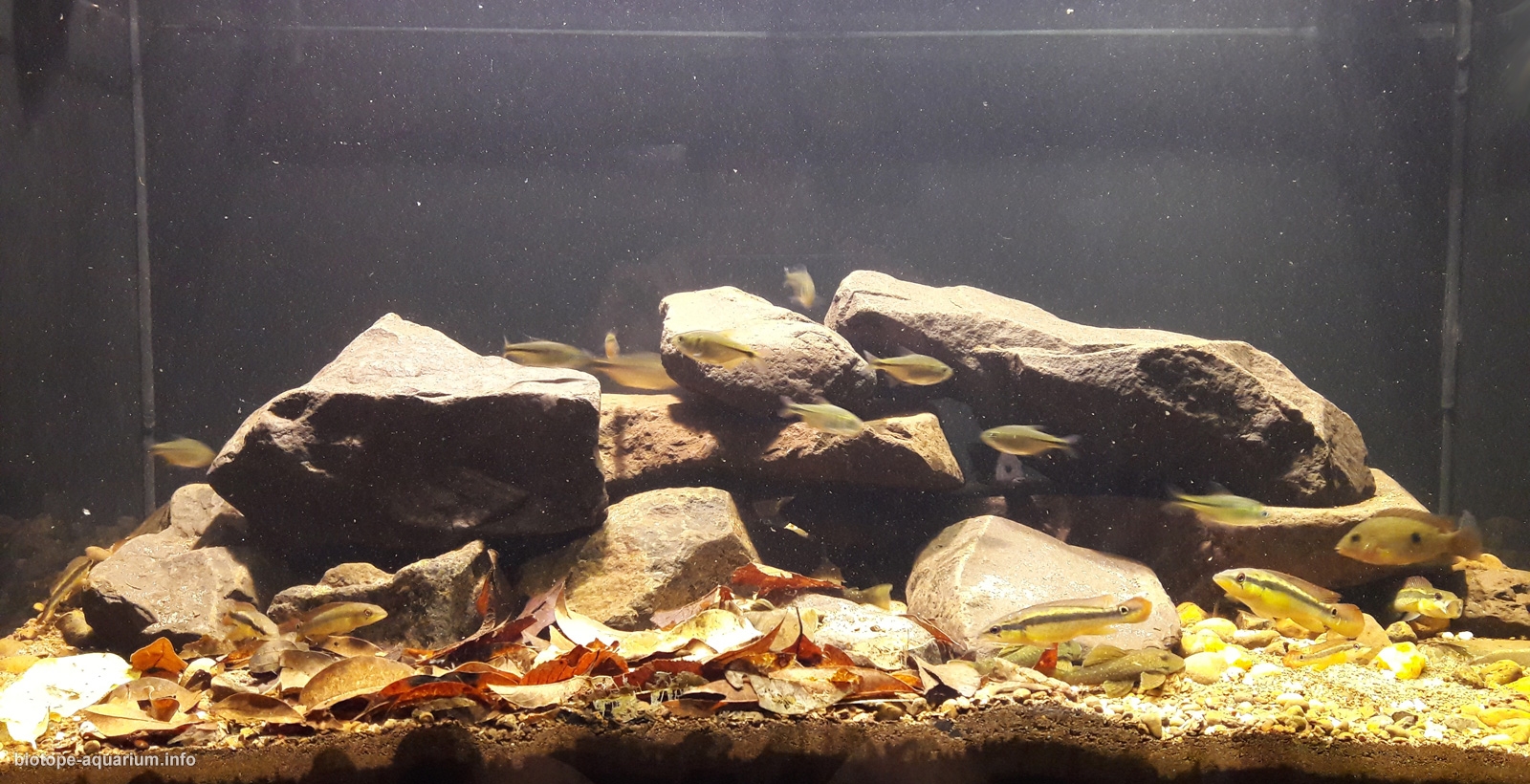Resisting under Alto Paraná Atlantic forests
81st place in Biotope Aquarium Design Contest 2017
![]() Argentina. Cesar Gabriel Schmitke
Argentina. Cesar Gabriel Schmitke

Volume: 250 L
Dimensions: 100x50x50 cm
List of fishes: 2 Crenicichla gaucho males, 5 Crenicichla gaucho females, 5 Australoheros ykeregua, 5 Hemiancistrus fuliginosus, 5 Astyanax paris, 10 Bryconamericus uporas
List of plants: N/A
Description of decorations: The decoration of the aquarium is just as it is found in nature. It was composed of stones, substrate and leaves collected from the stream, not to lose natural style, this way achieving an environment where the fish feel at home. The stones are volcanic. The substrate is formed by sandstone of very small size (produced by the erosion of the volcanic stones), sand, laterite, leaves of trees.
Description of equipment: Eheim Professional Filter 3 600/2075, 250W heater, air pump, 2 equipments HQI of 70W 5000K
Water parameters: Temperature is 24°C, pH is 7, GH is 2°dH, KH is 4°dH
Description of the area surrounding the biotope: The Tuerto Channel (known by locals as the Yerbas del Paraiso stream) is located in the Province of Misiones, Argentine Republic, in the city of El Soberbio. The coordinates are 27°14’05.3″S 54°02’38.1″W (-27.234791, -54.043912). To reach this waterfall you should go from El Soberbio by route 2 to the Moconá waterfalls, approximately 33 kilometers to a few meters before the Paraiso stream bridge. The area surrounding the biotope is covered with trees and shrubs, serving as a natural barrier of the predominant local farms. The Tuerto stream is a tributary of the Paraiso stream, both belonging to the Uruguay River basin. Before the mouth, the Tuerto Channel has a waterfall of about 3.50 meters heigh. In the place you can see volcanic rocks of various sizes, which are outside and inside the water channel.
Description of the underwater landscape of the biotope: The underwater landscape is formed by a rocky bottom, where we can see volcanic rocks and large plates. The substrate is a kind of sand of very fine size, which is formed by the erosion of the stones and the soil (laterite). Leaves of trees fall into the water giving different colors to the bottom of the stream. The fish use those leaves and holes in the rocks as hiding places. Trunks and branches are also present, but not so many. The depth in this part is approximately 1 meter. In its channel we can find areas of calm waters as well as faster currents, to be less deep. The Crenicichla gaucho are very curious fish in their natural state, as well as in aquaria. During the day they usually swim in shallow areas, usually in groups of 10 members. At night they use hollows under stones to rest in calm waters. We always can find the couple resting in nearby places, not under the same stone, but very close. On the other hand, the Australoheros ykeregua are much more shy fish and when they see minimum movement, they seek refuge under stones or driftwood. During the day you can see them swimming next to schools of Astyanax paris adults. At night, they look for calm waters to rest. The Astyanax paris and Bryconamericus uporas are scooling fish, always together and swim in the middle and upper part of the stream. They look for food on the surface, almost always insects that fall into the water. At night, they can be seen resting in schools of 5 to 15 members. Both Parapimelodus valenciennis and Heptapterus mustelinus are hard to find during the day; they usually hide under the stones, driftwood, leaves or the bedrock substrate. But at night, they are super active fish since it is time when they seek food, although when they see minimum movement, they seek shelter. We can find Hemiancistrus fuliginosus at any moment of the day stuck to stones, leaves or driftwood. It is easier to find them at night, traversing the surface of stones in search of food.
Description of the parameters of the habitat: pH: 7.4, GH: 5°dH, KH: 6°dH, temperature: 20.5°C, in summer it is from 25°C to 27°C.
List of fishes: Crenicichla gaucho, Australoheros ykeregua, Hemiancistrus fuliginosus, Astyanax paris, Bryconamericus uporas, Parapimelodus valenciennis, Heptapterus mustelinus.
List of plants: N/A
Threats to the ecology: The main ecological threat in this area and many areas of Misiones is deforestation and indiscriminate tree felling. Another factor is the planting of Pino elliotis for later use in the timber industry. The use of agrochemicals without measuring secondary consequences is also a pollution factor. Lack of education in caring for streams, jungles, animals, also has an effect on the ecosystem and the environment in Misiones. This makes more important the construction of urban territories and routes without damage that they cause to the nature.
Sources of information: http://misionesnatural.com/salto-yerbas.html
